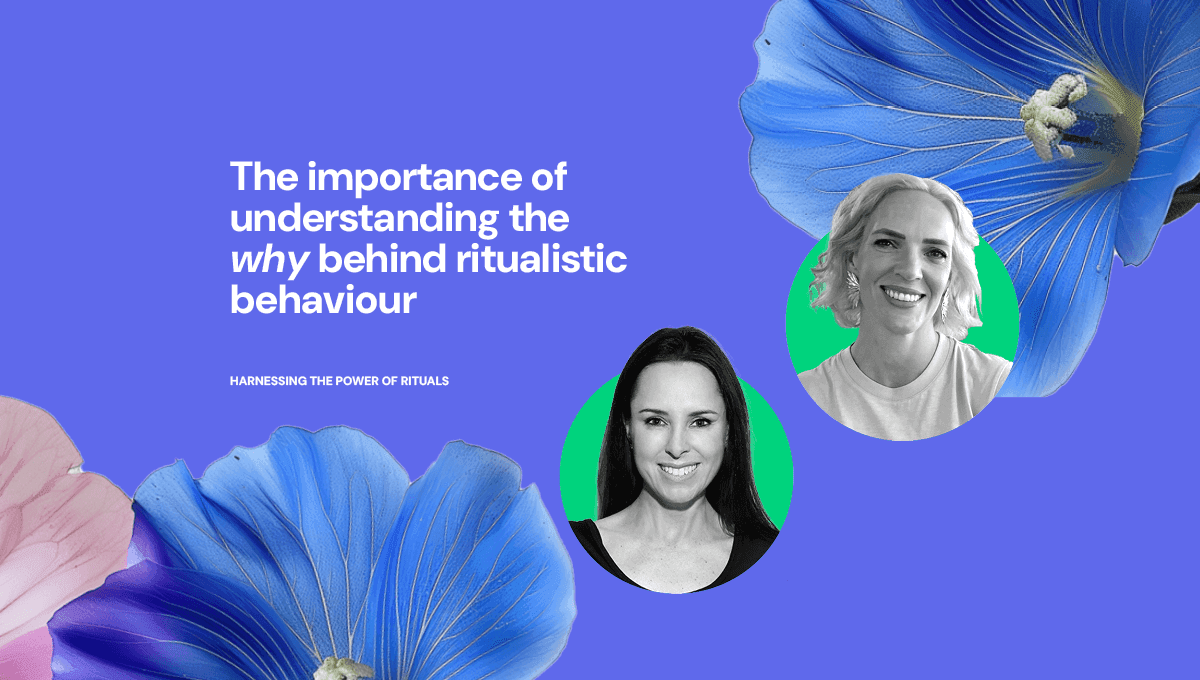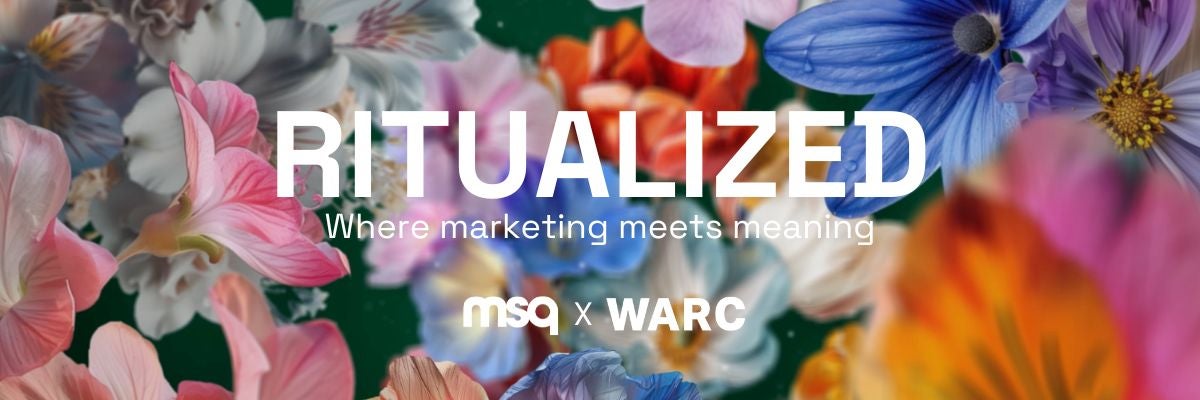 Home Page
Home PageThe importance of understanding the why behind ritualistic behaviour

As part of our research white paper in partnership with WARC, "Harnessing the Power of Rituals", we spoke to senior marketers across the globe to uncover their own experiences and insights around rituals, and their impact on consumers and brands.
In this next interview, Ellesha Kirby, Global Executive in Consumer Health and Beauty and previously Global Head, Skin Health & Beauty and Design at Kenvue, spoke to Kit Altin, Chief Strategy Officer at The Gate London.
To download the white paper and discover more about rituals, visit Ritualized.
Are there any rituals that play an important role in your life?
The difference between a ritual and a routine is that a ritual is more emotional: it's imbued with emotion. I have two kids and pets and a husband and a job – and even mundane things like making your bed or walking the dog can be elevated to a ritual when you attribute the meaning right.
We’ve been talking a lot about this as a family. My kids are teenagers and it’s hard to get them to make their bed in the morning. But we read about a part of psychology that says if you make your bed in the morning, it's like it's your first goal of the day. There's even data that says you're much more successful as a person if you make your bed in the morning. And I thought that was such a great example of the difference between a routine and a ritual; it’s all about the frame that you put around it. It’s so interesting that it's not about what it is, it's about what it means to us that actually is the difference.
What are some of the bigger trends you've been seeing in the categories that you've been working within?
In beauty and skin care it’s interesting because there is a polarisation in beauty between the people who are the maximalists, and the people who are the minimalists.
And when you think about beauty, it is so emotionally driven. You really peel the onion as you think about different kinds of rituals in beauty. Every one of those rituals is just about being present in some way, shape or form, whatever beauty means to you.
There’s an old saying in Asian culture, ‘There are no ugly women, only lazy ones’. As we think about beauty and rituals and routines – regardless of whether someone is a maximalist or a minimalist – there is an emotional pay-off from making an effort.
I thought it was fascinating that no matter what the action is, there's a ‘why’ for whether I want to use a lot, or for whether I want to use a little. That polarisation speaks to the fact that it’s deeply emotional, and how that impacts your purchase, usage and social behaviour. With social, no other consumer health or FMCG category has the same amount of content and engagement as the beauty category does. There's something tremendously impactful and emotionally satisfying about sharing rituals with other people, which I don't think we see anywhere else.
Do you have a hypothesis on why that is? What is it about beauty that particularly lends itself to sharing?
It's the ritualisation of elevating something which might be more of a routine to something that is so invested. When you think about the culture that we're now in, and how visual we've become as a society with social media like Instagram and TikTok, it makes sense. But that's only in the last 10 or so years. What we're talking about has persisted for decades and centuries.
Can you talk a bit more about the emotional pay-off from effort? This is at the heart of rituals. For example, when General Mills was trying to sell more Betty Crocker cake mix, they made one change to the recipe where you needed to add an egg. This introduction of effort saw it take off.
When you think of innovation, if you have to make the slightest bit too much effort it's dead. So that’s why as marketers we have to get to the deeper ‘why’. Betty Crocker is such a fabulous example because it's all about your pride as a house-maker. It can't be too easy because otherwise, you're probably not as good [at baking] as you should be.
With beauty, consumers would rather do five steps than mix two things together, and there’s something really fascinating about what they think they’re getting from that.
We talk a lot about the pre-ageing trend – it’s language taken from China a few years ago. And what we saw is that young women in their late teens and early 20s are really starting to move heavily into active skincare. For example using retinol, vitamin C and all the different ingredients that were such buzzwords following COVID-19.
At the heart of it, we had this amazing consumer insight from Japan that was ‘My mother is amazing, ageing is natural. But I don't want it.’ They want to look like themselves, but they don’t want to look old. In China, what was really interesting a few years ago, is that it started to manifest in consumer behaviour. In the last five to ten years there’s this fascinating stat that more than 50% of consumers in the USA and China are using anti-ageing products without seeing any visible sign of ageing.
So, they're using a product with no physical benefit, only an emotional benefit. That's all, because it's about investing in themselves, their self-care, and their beauty. In order to avoid an outcome 20 or 30 years in the future. It's like an insurance for future transformation.
Historically, rituals have been community and religious-based. We're now seeing them become a support for the individual – and that naturally fits into the self-care world. How does this manifest in the category?
If I reflect on my own life, apart from the rituals that are culturally hard-wired like Christmas or big festivals, I definitely have more personal rituals with my family. What’s interesting is that it's meaningful for me on my own, it's meaningful for me to talk about it with someone without any participation, and then it's also meaningful for me to do it with other people. Meaning creates connection.
I also think there's something in rituals where you want it to be good. It's always positive, the payoff is never negative. Rituals should always have some kind of optimistic, growth outcome. Routines are not like that. If I don't attach meaning to it nobody cares.
In our research into rituals we look at a world that’s become obsessed with efficiency and the role of rituals as a fight-back against that. Do you see this within marketing?
Budgets are challenging, and growth is harder to achieve, but as a marketer, you can never trump the power of insights. If you don't know what problem you’re solving (and why that's important to someone) then you might as well not bother. Marketing's job is to remind, and not to convince. Insight to me is really where the magic lies.
I initially thought about efficiency in skincare and beauty. There's been a huge shift towards science, and whilst aesthetics are still critically important, brands have moved away from that ‘hope in a jar’ thing that beauty was for decades. It’s now about customers wanting ‘three ceramides to remove my wrinkles in one week’ – something really hard and fast.
That brings me back to the Derm trend, which is huge in skincare. Perhaps it’s rebalancing. If you think about some of the craziest trends – we talked about pre-ageing and the Sephora Kids trend (where you have 9- and 10-year-olds using retinol) – they've heard that it's the thing, they go and do it, and it’s over the top. The beautiful thing with Derm content is that it has the voice of a doctor, particularly in a TikTok environment. It allows you to take a step back and refocus on what is most beneficial, essential and relevant to you.
From the old world of hope-in-a-jar to today where everyone is learning through social media, do you think the category is becoming more or less ritualised over time?
It's definitely much more public with social media, like the rise of influencers and influencer and creator marketing. There's something incredibly satisfying about watching people put skincare on. I do not know why that should be!
Maybe it’s a whole new category of watching other people engage in their rituals. It’s that middle bucket we talked about earlier, made possible with the rise of social media. Again, there's some emotional pay-off that's so deeply hard-wired. It would be fascinating to dive more deeply into this, to show the exact emotional benefit of watching someone perform a ritual.
Can you see any risks or rewards for marketers seeking to tap into ritualistic behaviours?
I call it an ethical dilemma – which is quite formal – but think about some of the things that are coded around beauty. Whilst I don’t believe any brand would seek to do this overtly, the category does reinforce stereotypes that are not always helpful to women. Even in a world of body positivity and celebrating diversity and identity, which I'm very passionate about, some of these things do end up becoming a smaller priority.
I think that the reward is in understanding the why. It’s so rich and powerful when you're trying to communicate with another human.
The risk is that if the ‘why’ is something that is culturally programmed in a way that few want to go in the future, you don't want to be seen as encouraging that. We need to create new stories that are the picture that we want to create, rather than the picture of the past. As we said at the beginning, humans are very slow to change and we don't want to perpetuate things that don't serve us anymore.
And in that middle bucket, where we’re watching people engage in positive rituals, that in itself can be a way that marketing can add value to the world. If seeing people clean their house makes us all happy, then for brands that are in that space it's a way to create a positive halo effect.
Have you ever consciously sought to tap into consumer rituals, either in the past or recently?
Certainly, routines such as the whole 3, 5, 10 step skincare approach we talked about. I think every company looks at how they structure their portfolio and how consumers shop. Those kinds of things become the codes and cues of the whole category. In that regard, it’s very much hard-wired into what brands you have, how they show up, and how different products interact with each other. There's a certain order to things.
But what this conversation has got me thinking is ‘how do you elevate that to the status of ritual versus it being about routine?’, because when I think about the shelf, it's routine. We have not completely unlocked the power of ritual.
VISIT THE RITUALIZED HOMEPAGE, HERE

Further reading



